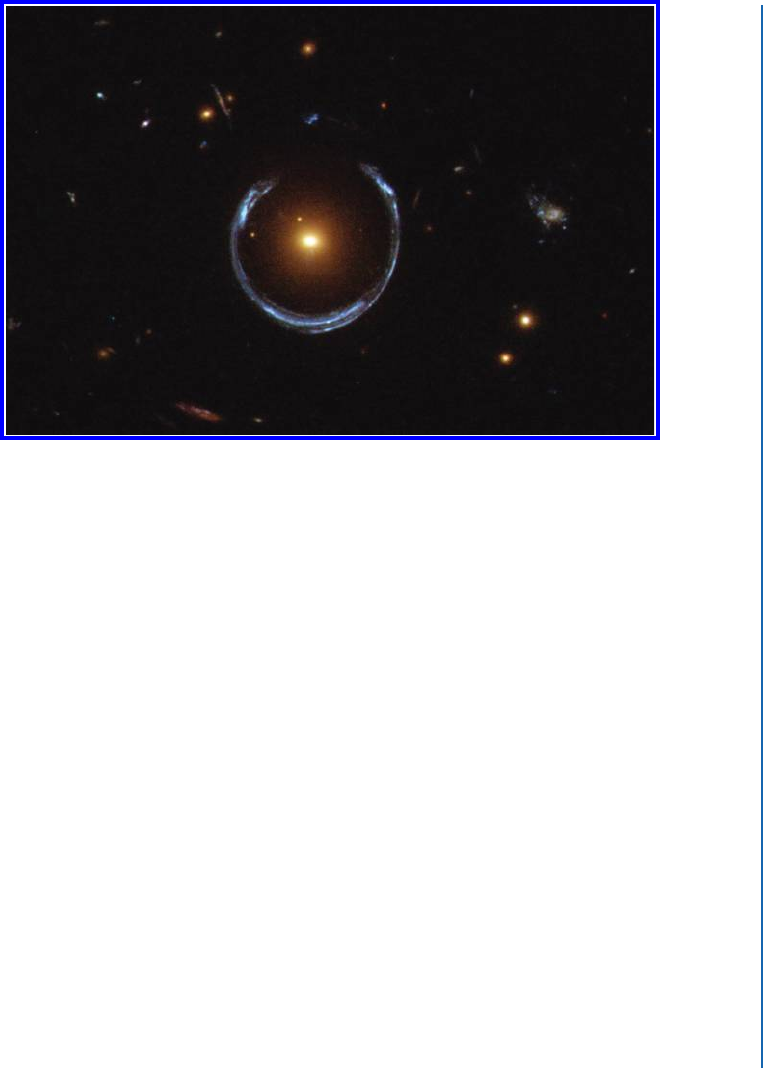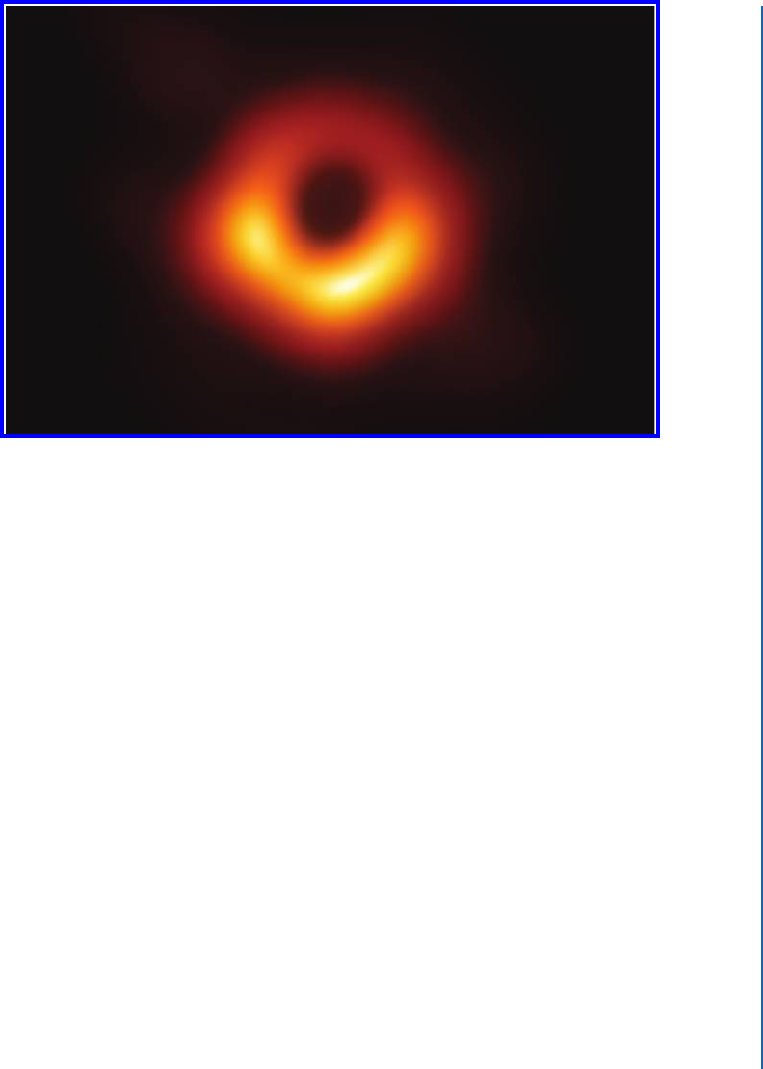
11.2. EINSTEIN’S GRAVITATIONAL FIELD 153
But if gravity is the only force acting upon the object, then Newton’s law of universal
gravitation proclaims that:
†
E
F D m
g
Eg; (11.11)
where Eg is the local strength of the gravitational field where the object is dropped. is is mass
as measured by gravity, and so I have used m
g
to represent the gravitational mass of the object.
If we combine Equations (11.10) and (11.11) for the case of an object falling under the
influence of gravity alone, we have:
Ea D
m
g
m
i
Eg: (11.12)
Equation (11.12) implies that if m
g
D m
i
, then Ea D Eg and the acceleration is simply equal
to the local value of the gravitational field, regardless of what mass is placed there. And so all objects
would experience the same acceleration in a given gravitational field, if they are acted upon only
by gravity.
We can thus test whether or not m
g
D m
i
by performing a simple experiment; drop dif-
ferent objects in a gravitational field and measure whether or not their accelerations are indeed
equal. Galileo was the first to describe this experiment, allegedly dropping objects off the leaning
tower of Pisa.
5
Since Newton’s time, the experiment has been performed repeatedly, to higher
and higher levels of precision. And no one has ever convincingly discovered evidence for any
difference between gravitational and inertial mass. is experimental result—that inertial and
gravitational mass are equivalent to each other even though they seem to have very different
definitions—is one way to state Einstein’s equivalence principal, a cornerstone of his general the-
ory of relativity we discuss in Section 11.2.
11.2 EINSTEIN’S GRAVITATIONAL FIELD
Instead of somehow “tweaking” Newton’s law of gravity to include a speed-of-light time delay,
Einstein started over. He took Minkowski’s cue that special relativity could be interpreted as
a geometric theory (see Section 5.1.4), and spent the next ten years developing an elegant new
theory of gravity based on geometry. It is called general relativity (GR), and its foundation was
published in 1915. Some of the most basic principals of GR are listed below.
• e equivalence principal. ere is no distinction between gravitational mass and iner-
tial mass—there is only mass (and it’s equivalent energy). is means that the motion of
every material body is affected the same, in a given gravitational field. e equivalence prin-
cipal also means that, when looking at only a very small region of space and time, gravity is
indistinguishable from an ordinary acceleration.
5
Interestingly, it is not clear whether Galileo actually performed the experiment at all. His argument, foreshadowing
Einstein in many ways, was rather that it should be true that all objects would fall the same [Ferris, 1988, pp. 83–94].
154 11. FIELDS
• Gravity is not seen as a force in GR. Material bodies move under the influence of gravity
the same way they move when under no force at all—they move in straight lines. But in
GR, bodies move in straight lines not in ordinary three-dimensional space, but in four-
dimensional spacetime. Such a straight line in spacetime is called a geodesic.
• e very geometry of spacetime is altered by the presence of mass to be non-Euclidean
(see Section 2.1.1). e presence of mass alters both the geometry of space and the rate at
which time passes. is means the geometry of four-dimensional spacetime is altered by
the presence of mass.
• Because mass alters the geometry of spacetime, mass changes the meaning of what is a
straight line in space and time. And so particles move in different paths through space
than they would if no mass were present.
• Light beams travel on null geodesics. A null geodesic occupies zero time—the light beam
is everywhere along its path at once. But it travels in a straight line through ordinary (but
curved) space alone. And so light beams can be used to trace out the non-Euclidean three
dimensional space, curved by the presence of mass.
And so the presence of mass tells space and time how to “curve”—to assume a geometry
different from the ordinary Euclidean geometry we know and love. Matter then moves in what
is a straight line through this altered four-dimensional geometry—and thus follows a path that
is different than it would have if no mass had been present.
Earth does not feel a force of gravity from the Sun. Rather it is simply moving in a straight
line through whatever space and time it happens upon. But that spacetime has been altered by
the presence of the enormous bit of mass we call the Sun. And so there is no spooky “action at
a distance;” all action is local.
11.2.1 GRAVITATIONAL LENSES
Because light rays trace out the local curvature of space, the presence of a large amount of mass—
from a galaxy or cluster of galaxies for example—can act as a sort of lens. More distant light rays
bend around the concentration of matter, and this means rays of light that would have missed
us can be deflected in our direction.
See Figure 11.5 for the most extreme example—an Einstein ring. Rays from many angles
have been deflected to us, stretching the image of a distant galaxy into a thin ring. Far more
often, the alignment of the gravitational lens is not so perfect.
Gravitational lenses such as that shown in Figure 11.5 can be used to probe the curvature of
space on the large scale. is provides another observational constraint on cosmological models
that assume the curvature of the universe is flat on the large scale.

11.2. EINSTEIN’S GRAVITATIONAL FIELD 155
Figure 11.5: An example of the most rare type of gravitational lens—an Einstein ring. e thin
ring of light is a galaxy behind the one at its center. e curvature of space has bent light from
the more-distant galaxy around the nearer one, allowing us to see it in many directions at once.
(Image credit: ESA/Hubble and NASA, CC BY-SA 4.0.)
11.2.2 NEUTRON STARS AND BLACK HOLES
A neutron star is an extremely compact object; an enormous amount of mass (roughly twice the
mass of the Sun) is contained within a tiny volume (a sphere the size of a small city). is means
the curvature of spacetime nearby is not at all subtle.
is affect of gravity on spacetime can be measured directly in a few cases, such as the
double pulsar PSR J0737-3039. A pulsar is a rapidly-rotating neutron star, that emits beams of
radio waves somewhat like a light house. If we happen to be in the path of the beam, it flashes
toward Earth every rotation of the neutron star. us, we see a regular flash of these radio waves.
Because of the conservation of angular momentum, pulsars rotate very fast, with periods
of only seconds or even tiny fractions of a second. e pulsars in PSR J0737-3039 rotate with
periods of 2.773 seconds and 22.699 milliseconds, respectively. e short orbital period of a
pulsar makes it, in effect, a clock. And so we can use the pulses to monitor the difference between
the pulsar’s rate of time passage and our own.
Detailed analyses of the orbits of this binary pulsar require GR; if GR is ignored in the
calculations, then the predicted orbit disagrees with what we observe. GR on the other hand—
including the production of gravitational waves—gives answers that agree with observation.

156 11. FIELDS
If the mass of a neutron star were to be compressed to only slightly smaller volume, it
would form a black hole—an object so dense that the extreme curvature of space prevents even a
light beam from escaping it.
If mass is confined within a certain radius such that even light cannot escape the gravity,
then a black hole is formed. is radius is known as the Schwarzschild radius, and it sets the
effective size of a black hole. And so we imagine a sphere with a radius equal to the Schwarzschild
radius. e surface of this sphere is called the event horizon—anything that passes through it
cannot return.
e Schwarzschild radius, R
S
, of a black hole depends only upon its mass, M , and it has
a surprisingly simple formula:
R
S
D
2GM
c
2
; (11.13)
where G is the gravitational constant and c is the speed of light. If we express M in units of the
mass of the Sun, the Schwarzschild radius is approximately 3 km for every solar mass.
Black holes greatly alter the spacetime nearby, but at large distances their gravity is not
significantly different from what it would be if the same amount of mass were not compact and
in the form of a black hole.
e black holes that remain from the collapse of massive stars are very difficult to detect; it
is practically impossible for a solitary black hole. But in a close binary star system, the companion
star may transfer matter to the black hole, and this produces X-rays that are detectable. ere
are several such examples known.
But by far the most easily detectable black holes are the supermassive black holes found
at the centers of many large galaxies. Figure 11.6 shows the first successful “photograph” of a
supermassive black hole—in the center of the giant elliptical galaxy M 87.
is remarkable image was released in April, 2019 by the Event Horizon Telescope team.
e dark hole in the center of the image is larger than the Schwarzschild radius of the black hole.
It represents the edge of the ergosphere—a region around a black hole where light beams would
essentially orbit the concentration of mass. e mass calculated for this supermassive black hole
is about 6.5 billion times the mass of the Sun.
11.2.3 DARK MATTER AND DARK ENERGY
e nature of dark matter (see Section 5.4.5) is consistent with a type of matter that behaves, so
far as gravity is concerned, the same as any other matter. It is its interactions with other known
forces (electricity, magnetism, and the forces within the nucleus of an atom) that are unusual.
But so-called dark energy (see Section 5.4.6) is another kettle of fish. Dark energy is the name
for the recent observation that the universe is accelerating its expansion, rather than slowing
down as one would expect from “normal” gravity. e cause of this acceleration is unknown, but
it has a deep connection, historically if nothing else, to Einstein’s GR.

11.2. EINSTEIN’S GRAVITATIONAL FIELD 157
Figure 11.6: An image of the ergosphere of the supermassive black hole in the center of the giant
elliptical galaxy M 87, made with the Event Horizon Telescope. (Image credit: EHT Collabo-
ration, CC BY 4.0.)
Shortly after Einstein published his first papers on GR, he realized that it had cosmo-
logical implications. His equations implied that the universe could not be static—it must either
expand or contract. is was 1915, and the expansion of the universe would not be discovered
by Edwin Hubble for decades.
Einstein believed, wrongly, that the universe as a whole must be static. And so in 1916 he
proposed to modify his equations with a cosmological constant. It was a fudge factor. e term,
signified by the Greek letter ƒ (lambda), allowed for what amounts to a repulsive effect of space
itself at very large distances. is could, for the universe as a whole, balance the overall attractive
effect of “ordinary” gravity. On the small scale (in the laboratory or even the solar system), it
would be essentially undetectable.
When Hubble discovered the expansion of the universe, Einstein disavowed the cosmo-
logical constant, calling it his biggest blunder. But with the development of quantum physics
over the next few decades, other physicists were not so sure. Quantum physics does predict that
space itself should have some kind of energy associated with it—and GR says that energy should
have gravitational effects. But even a quick quantum-mechanical calculation gives an answer that
is not only wrong, it is absurd.
And so for many decades, no one knew what to do with Einstein’s cosmological constant.
ere are some theoretical reasons for expecting it to exist, but actual calculations with existing
..................Content has been hidden....................
You can't read the all page of ebook, please click here login for view all page.
